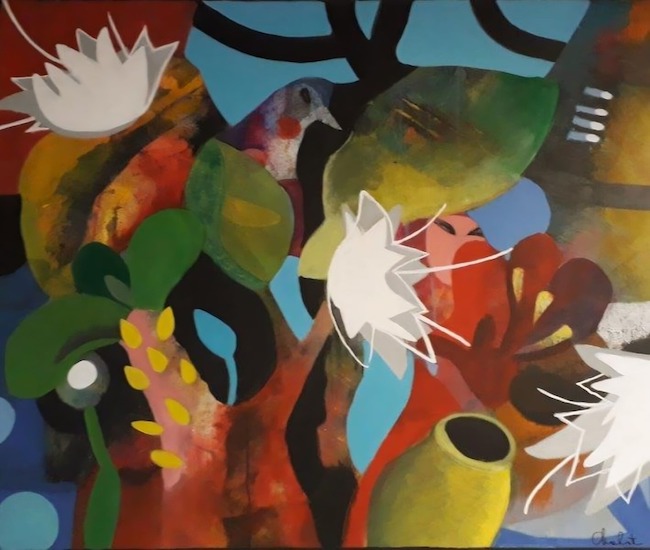La natura è stata costantemente oggetto delle attenzioni degli artisti di ogni secolo, a volte utilizzata come simbolo della stretta connessione con l’uomo, altre come sinonimo di evasione da una realtà soffocante e ostile, altre invece come espressione di una forza inarginabile da cui l’essere umano non era in grado di proteggersi, e in alcuni casi era rappresentata come un mondo fantastico, sognante, dentro cui tutto poteva essere possibile. La protagonista di oggi mostra un approccio fanciullesco alla rappresentazione della realtà, mescolando elementi che non potrebbero trovarsi insieme se non in un’opera d’arte e tendendo a volte verso un’astrazione che contribuisce a infondere nell’osservatore la sensazione di trovarsi davanti a un mondo da fiaba.
Nel momento in cui la realtà cominciò a essere troppo ordinaria, o noiosa oppure limitante per poter essere riprodotta come era stato fatto fino a poco prima, si delinearono negli artisti che operavano nel periodo a cavallo tra la fine dell’Ottocento e l’inizio del Novecento degli inediti approcci alla pittura e alla scultura, dei tentativi di trovare linguaggi espressivi inaspettati, sorprendenti proprio per la loro totale mancanza di fedeltà a tutto ciò che lo sguardo poteva cogliere. Nell’ambito di questa vera e propria rivoluzione vi fu una parte sostanziosa di creativi che considerò l’evasione dalla realtà uno dei principali obiettivi, perché solo attraverso il sogno, la trasposizione fantastica di un vissuto altrimenti troppo povero di sensazioni, era possibile esprimere pienamente la loro anima, il loro sguardo alla vita. Da un lato vi furono gli Espressionisti, in particolar modo i francesi, che vollero utilizzare quella bizzarra figurazione priva di profondità, di senso della prospettiva, avvolta da colori completamente decontestualizzati ed eccessivi, per raccontare di emozioni semplici, basiche quasi, di un mondo fatto di piccole cose in grado di infondere gioia per il solo fatto di essere presenze rassicuranti nella vita di ciascuno. Ecco dunque che le ambientazioni a tinte forti di Henri Matisse erano in grado di sottolineare il suo punto di vista sull’esistenza, sulla necessità di naturalezza in una società che stava diventando troppo formale e superficiale; di contro invece il sognatore Marc Chagall dipingeva le sue emozioni più sincere, rappresentando un mondo fatto d’amore, di leggerezza, di capacità di sognare e di distaccarsi dalla contingenza per entrare nella dimensione dell’idealismo e dell’idillio. Nello stesso periodo emerse un altro movimento pittorico contraddistinto da immediatezza espressiva e da un approccio figurativo completamente estraneo sia alla realtà osservata che alla società dell’epoca e anche a una qualsiasi preparazione accademica da parte degli artisti che vi aderirono, per lo più di formazione autodidatta. Parlo del Naïf in cui tutto l’impossibile diventava possibile in virtù della fantasia libera e senza regole degli esecutori delle opere che descrivevano ambientazioni improbabili, abitate da personaggi immaginari che riempivano le tele prive di qualsiasi struttura prospettica, esattamente allo stesso modo in cui molti secoli prima Hieronimus Bosch aveva scelto di contraddistinguere il suo percorso artistico. L’ingenuità espressiva di Henri Rousseau, di Antonio Ligabue, di Emilio Tadini, furono in grado di far sognare intere generazioni di appassionati malgrado lo sguardo di sufficienza con cui furono osservati ai loro esordi dal mondo culturale dell’epoca.
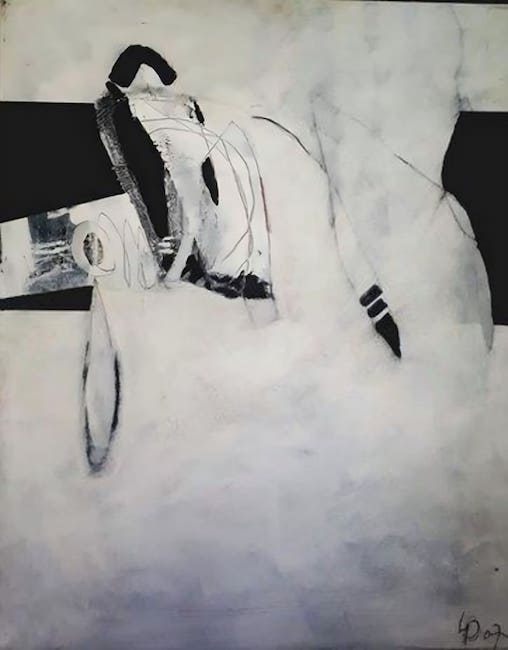
L’artista austriaca Lotte Pucher fonde in un unico stile non solo le caratteristiche cromatiche e compositive dell’Espressionismo con l’immediatezza rappresentativa del Naïf, di cui riprende anche la tendenza a raccontare della natura, ma in alcuni casi tende persino verso un Astrattismo che però non rinuncia mai completamente alla figurazione, come se la sua inclinazione a trascinare l’osservatore in un mondo fantastico, fatto di possibilità impensate, non potesse rinunciare a catturare l’attenzione attraverso piccoli e velati riferimenti alla realtà osservata. Perché forse è solo in virtù del conosciuto che ci si può lasciar trasportare da una possibilità differente, da qualcosa che esiste solo nell’immaginazione ma che può anche costituire un modo migliore di affrontare le cose, e la vita.
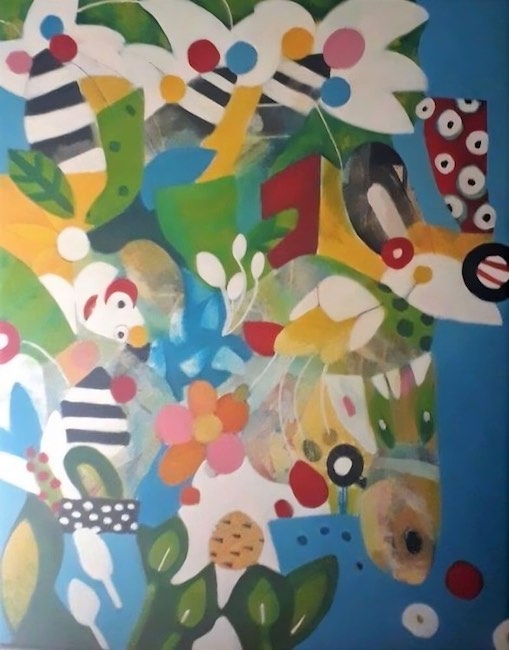
La composizione dell’opera è irreale, la natura sembra avvolgere personaggi appena riconoscibili all’interno del groviglio di fiori e di foglie, come se per Lotte Pucher la realtà potesse essere guardata solo nella sua frammentazione, in quelle piccole parti che come un puzzle compongono il senso del tutto; ciascun elemento è parimenti rilevante dunque, non esiste una predominanza di un dettaglio su un altro perché in fondo ciò che accade, ciò che entra per un momento più o meno breve nella vita delle persone assume rilevanza avendo il potere di mostrare aspetto diverso, o semplicemente indurre a riflettere su un lato di sé che altrimenti non sarebbe emerso.
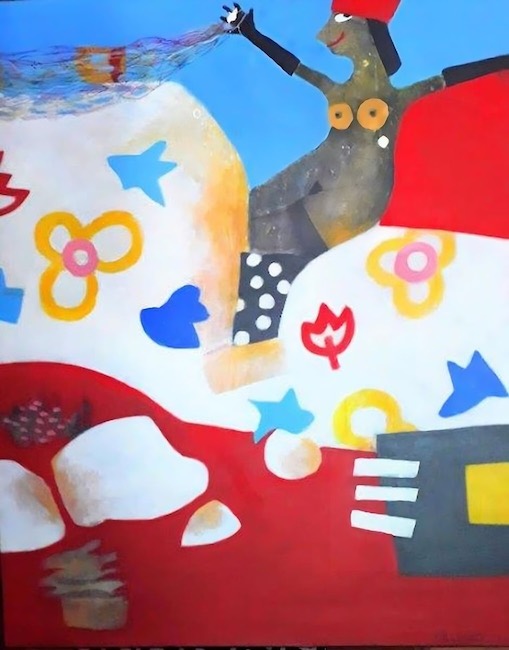
La particolarità dell’artista è di dare vita a personaggi singolari, bizzarri, che a malapena hanno sembianze umane, quasi come se volesse eliminare tutte le gabbie della forma esteriore per lasciare spazio all’essenza, a quella leggerezza necessaria ad affrontare l’esistenza che però non significa superficialità, piuttosto semplicità e immediatezza; è per questo che il linguaggio più adeguato è quello della fiaba, delle atmosfere sognanti a metà tra l’idealismo di Marc Chagall e lo stimolo all’immaginazione del Naïf di Henri Rousseau, scegliendo però una gamma cromatica più affine alla sua delicata natura femminile. Nella tela Meerjungfrau, la sirena protagonista non si trova nel mare, quanto meno non quello dell’immaginario comune, bensì sembra galleggiare in una dimensione onirica dove nulla ha l’aspetto che ci si aspetterebbe, pertanto l’acqua è rossa, i pesci e le piante marine sono stilizzate e semplificate quasi a enfatizzare l’aspetto irreale della figura mitologica. La struttura dell’opera è a sua volta ridotta all’essenziale, sia dal punto di vista stilistico che da quello della prospettiva e della presenza degli elementi che la compongono, perché ciò che deve emergere è appunto la mancanza di complicazioni, di ricerca di una perfezione formale che troppo frequentemente allontana l’individuo dai valori più rilevanti.
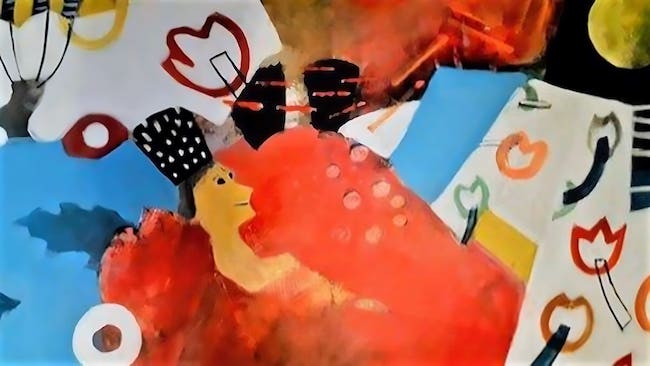
E così, come una contemporanea Alice nel paese delle meraviglie, Lotte Pucher guarda la natura intorno a sé con una sensibilità visionaria che le permette di porre in evidenza quanto tutto ciò che sembra silenzioso e inconsistente in realtà abbia una sua anima e viva di una sua vita, come emerge dall’opera Poppyflower, in cui il papavero non si limita a essere semplicemente un fiore bensì ha un aspetto umano, il suo pistillo osserva il mondo circostante cullandosi nel rosso dei suoi petali e perdendosi all’interno di un microcosmo fatto di piacevolezza, di colori, di innocenza da cui l’essere umano adulto tende completamente a distaccarsi. Ecco perché Lotte Pucher preferisce restare legata al mondo fanciullesco, proprio per suggerire al fruitore, di non dimenticarsi di quel lato ingenuo e spontaneo in grado di mantenere il legame con una purezza perduta quando il bambino ha lasciato spazio all’adulto; eppure, sembra suggerire l’artista, quella parte ha bisogno di fare capolino ogni tanto e ricordare all’adulto l’esistenza di quel bambino.

In Animals infatti l’artista racconta di un’ambientazione tanto improbabile quanto giocosa, dove lo sguardo si perde per trovare gli animali nascosti, come se quello della Pucher fosse un invito a scoprire ciò che è meno evidente, andando oltre la contingenza per entrare in una dimensione parallela dove tutto ciò che esiste stravolge l’aspettativa visiva e si diverte a ingannare chi si trova davanti alla tela.

Questo dipinto tende in maniera particolare verso l’Astrattismo, solo i dettagli degli occhi e la stilizzazione di alcune zampe resta evidente, tutto il resto è affidato all’intuizione, all’immaginazione attraverso cui scorgere in quelle sovrapposizioni di colore le forme completamente inaspettate e diverse da quelle conosciute. Ugualmente in Jaguar, la figura protagonista del titolo sembra mancare, mimetizzata dietro le grandi piante che la coprono e ne celano la presenza persino all’osservatore, che ancora una volta è chiamato a fare uno sforzo di fantasia per entrare in quel magico mondo evocato da Lotte Pucher. La pittura è per lei evasione, manifestazione del desiderio di mantenere un forte legame con il suo lato ingenuo, naïf appunto, per riuscire a guardare la contemporaneità con occhi differenti, con un maggiore distacco perché in fondo quando ci si rivolge alla natura, tutta la contingenza si allontana e si entra in una dimensione più armonica.
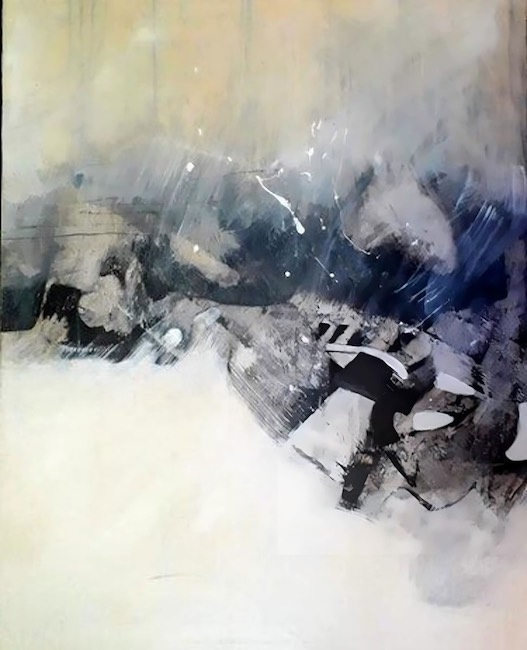
Nel corso della sua lunga carriera Lotte Pucher ha frequentato diversi corsi di pittura che le hanno permesso di misurarsi con varie tecniche pittoriche, l’acquarello, il disegno del nudo, illustrazione e caricatura, ha studiato in Italia con diversi maestri e attualmente partecipa a mostre collettive in tutta l’Austria.
LOTTE PUCHER-CONTATTI
Email: lolo-pu@hotmail.com
Sito web: www.charlotte-pu.art
Instagram: https://www.instagram.com/lottepucher/
The original look at nature in Lotte Pucher’s Expressionism, between naive atmospheres and improbable settings
Nature has constantly been the object of the attentions of artists in every century, sometimes used as a symbol of the close connection with man, sometimes as a synonym for escape from a suffocating and hostile reality, sometimes as an expression of an unconquerable force from which man was unable to protect himself, and in some cases it was represented as a fantastic, dreamlike world within which anything was possible. Today’s protagonist shows a childlike approach to the representation of reality, mixing elements that could only be found together in an artwork and tending at times towards an abstraction that contributes to instilling in the observer the feeling of being in front of a fairy-tale world.
At a time when reality began to be too ordinary, or boring or limiting to be reproduced as it had been until recently, artists working in the period between the end of the 19th century and the beginning of the 20th century came up with novel approaches to painting and sculpture, attempts to find unexpected expressive languages, surprising precisely because of their total lack of fidelity to everything the eye could grasp. Within this veritable revolution, there was a substantial section of creative artists who considered escapism from reality to be one of their main objectives, because only through dreams, the fantastic transposition of an experience otherwise too poor in sensations, was it possible to fully express their soul, their view of life. On the one hand, there were the Expressionists, especially the French, who wanted to use that bizarre figuration without depth, without a sense of perspective, wrapped in completely decontextualised and excessive colours, to tell of simple, almost basic emotions, of a world made up of small things capable of infusing joy by the mere fact of being reassuring presences in everyone’s life. Thus Henri Matisse‘s strong-coloured settings were able to emphasise his point of view on existence, on the need for naturalness in a society that was becoming too formal and superficial; on the other hand, the dreamer Marc Chagall painted his most sincere emotions, representing a world made of love, lightness, the ability to dream and to detach himself from contingency to enter the dimension of idealism and idyll. In the same period, another pictorial movement emerged, characterised by expressive immediacy and a figurative approach completely unrelated both to the reality observed and to the society of the time and also to any academic training on the part of the artists who adhered to it, most of whom were self-taught. I am speaking of the Naïf in which everything impossible became possible by virtue of the free and untrammelled imagination of the artists who described improbable settings, inhabited by imaginary characters who filled canvases devoid of any perspective structure, exactly in the same way as Hieronimus Bosch had chosen to mark his artistic career many centuries earlier. The expressive naivety of Henri Rousseau, of Antonio Ligabue, of Emilio Tadini, were able to make dream entire generations of enthusiasts, despite the look of sufficiency with which they were observed at their beginnings by the cultural world of the time.
The Austrian artist Lotte Pucher fuses in a single style not only the chromatic and compositional characteristics of Expressionism with the representational immediacy of Naïf, from which she also takes up the tendency to tell about nature, but in some cases even tends towards an Abstractionism that, however, never completely renounces figuration, as if her inclination to drag the observer into a fantasy world, made up of unimagined possibilities, could not renounce capturing attention through small, veiled references to the reality observed. Because perhaps it is only by virtue of the known that one can allow oneself to be transported by a different possibility, by something that exists only in the imagination but that can also constitute a better way of dealing with things, and with life. The composition of the artwork is unreal, nature seems to envelop barely recognisable characters within the tangle of flowers and leaves, as if for Lotte Pucher reality could only be seen in its fragmentation, in those small parts that like a jigsaw puzzle make up the sense of the whole; each element is equally relevant therefore, there is no predominance of one detail over another because after all what happens, what enters for a more or less brief moment into people’s lives takes on relevance by having the power to show a different aspect, or simply induce reflection on a side of oneself that would otherwise not have emerged.
The artist’s peculiarity is to give life to singular, bizarre characters, who barely have any human semblance, almost as if he wanted to eliminate all the cages of external form to leave room for the essence, for that lightness necessary to face existence, which however does not mean superficiality, rather simplicity and immediacy; it is for this reason that the most appropriate language is that of the fairy tale, of dreamy atmospheres somewhere between Marc Chagall‘s idealism and the stimulus to the imagination of Henri Rousseau‘s Naïf, but choosing a colour palette more akin to her delicate feminine nature. In the painting Meerjungfrau, the mermaid protagonist is not in the sea, or better not the sea of the common imagination, but seems to float in a dreamlike dimension where nothing looks as one would expect, so the water is red, the fish and sea plants are stylised and simplified almost as if to emphasise the unreal aspect of the mythological figure. The structure of the artwork is in turn reduced to the essential, both from the stylistic point of view and from that of perspective and the presence of the elements that compose it, because what must emerge is precisely the lack of complications, of the search for a formal perfection that all too often distances the individual from the most relevant values. And so, like a contemporary Alice in Wonderland, Lotte Pucher looks at nature around her with a visionary sensitivity that allows her to highlight how everything that seems silent and insubstantial actually has its soul and is alive with a life of its own, as emerges from the painting Poppyflower, in which the poppy is not merely a flower but has a human aspect, its pistil observs the world around it, cradling itself in the red of its petals and losing within a microcosm made up of pleasantness, colour and innocence from which the adult human being tends to detach completely.
This is why Lotte Pucher prefers to remain tied to the world of childhood, precisely to suggest to the viewer not to forget that naïve and spontaneous side capable of maintaining the link with a purity lost when the child has given way to the adult; yet, the artist seems to suggest, that part needs to peep out every now and then and remind the adult of the existence of that child. In Animals, in fact, the artist tells of a setting that is as improbable as it is playful, where the gaze wanders off to find the hidden animals, as if Pucher‘s was an invitation to discover what is less obvious, going beyond contingency to enter a parallel dimension where everything that exists disrupts the visual expectation and amuses by deceiving those who find themselves in front of the canvas. This painting tends towards Abstractionism, only the details of the eyes and the stylisation of some paws remain evident, everything else is left to intuition, to the imagination through which one can discern in those superimpositions of colour the completely unexpected and different forms from the known ones. Likewise in Jaguar, the protagonist figure of the title seems to be missing, camouflaged behind the large plants that cover it and conceal its presence even from the observer, who is once again called upon to make an imaginative effort to enter that magical world evoked by Lotte Pucher. For her, painting is an escape, a manifestation of her desire to maintain a strong link with her naïve side, to be able to look at the contemporary world with different eyes, with greater detachment, because after all, when one turns to nature, all contingency recedes and one enters a more harmonious dimension. Over the course of her long career, Lotte Pucher has attended various painting courses that have enabled her to measure with various painting techniques, watercolour, nude drawing, illustration and caricature. She has studied in Italy with various masters and currently participates in group exhibitions throughout Austria.


